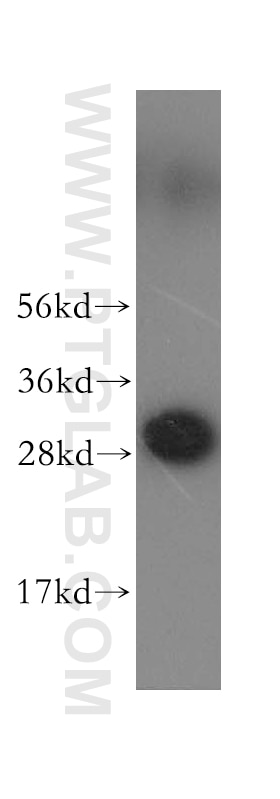Anticorps Polyclonal de lapin anti-VTI1A
VTI1A Polyclonal Antibody for WB, IF/ICC, IP, ELISA
Hôte / Isotype
Lapin / IgG
Réactivité testée
Humain, rat, souris
Applications
WB, IF/ICC, IP, ELISA
Conjugaison
Non conjugué
N° de cat : 12354-1-AP
Synonymes
Galerie de données de validation
Applications testées
| Résultats positifs en WB | tissu cérébral humain, cellules MCF-7, tissu cardiaque humain, tissu cérébral de souris, tissu pulmonaire humain, tissu rénal humain |
| Résultats positifs en IP | cellules MCF-7 |
| Résultats positifs en IF/ICC | cellules NIH/3T3 |
Dilution recommandée
| Application | Dilution |
|---|---|
| Western Blot (WB) | WB : 1:1000-1:4000 |
| Immunoprécipitation (IP) | IP : 0.5-4.0 ug for 1.0-3.0 mg of total protein lysate |
| Immunofluorescence (IF)/ICC | IF/ICC : 1:10-1:100 |
| It is recommended that this reagent should be titrated in each testing system to obtain optimal results. | |
| Sample-dependent, check data in validation data gallery | |
Applications publiées
| WB | See 9 publications below |
| IF | See 4 publications below |
Informations sur le produit
12354-1-AP cible VTI1A dans les applications de WB, IF/ICC, IP, ELISA et montre une réactivité avec des échantillons Humain, rat, souris
| Réactivité | Humain, rat, souris |
| Réactivité citée | Humain, souris |
| Hôte / Isotype | Lapin / IgG |
| Clonalité | Polyclonal |
| Type | Anticorps |
| Immunogène | VTI1A Protéine recombinante Ag3018 |
| Nom complet | vesicle transport through interaction with t-SNAREs homolog 1A (yeast) |
| Masse moléculaire calculée | 217 aa, 25 kDa |
| Poids moléculaire observé | 25-29 kDa |
| Numéro d’acquisition GenBank | BC017052 |
| Symbole du gène | VTI1A |
| Identification du gène (NCBI) | 143187 |
| Conjugaison | Non conjugué |
| Forme | Liquide |
| Méthode de purification | Purification par affinité contre l'antigène |
| Tampon de stockage | PBS with 0.02% sodium azide and 50% glycerol |
| Conditions de stockage | Stocker à -20°C. Stable pendant un an après l'expédition. L'aliquotage n'est pas nécessaire pour le stockage à -20oC Les 20ul contiennent 0,1% de BSA. |
Informations générales
Fusion between membranes is mediated by specific SNARE (soluble N-ethylmeleimide-sensitive factor attachment protein receptor) complexes. Two human SNARE proteins, VTI1A and VTI1B, are homologous to the yeast Q-SNARE Vtilp which is part of several SNARE complexes in different transport steps (PMID: 12067063). VTI1A is involved in transport between the endosome and the trans-Golgi network. The SNARE complex of STX10, STX16, VTI1A, and VAMP3 is required for MPR (mannose 6-phosphate receptors) transport from endosomes to the Golgi after delivering lysosomal enzymes to the endocytic pathway (PMID: 18195106). Transport from early/recycling endosomes to the TGN is mediated by the SNARE complex of STX6, STX16, VTI1A and VAMP4 (PMID: 11839770; 21807881).
Protocole
| Product Specific Protocols | |
|---|---|
| WB protocol for VTI1A antibody 12354-1-AP | Download protocol |
| IF protocol for VTI1A antibody 12354-1-AP | Download protocol |
| IP protocol for VTI1A antibody 12354-1-AP | Download protocol |
| Standard Protocols | |
|---|---|
| Click here to view our Standard Protocols |
Publications
| Species | Application | Title |
|---|---|---|
J Cell Biol The COG complex interacts directly with Syntaxin 6 and positively regulates endosome-to-TGN retrograde transport. | ||
Oncogene Syntaxin-6 mediated autophagy confers lenvatinib resistance in hepatocellular carcinoma | ||
J Cell Sci The COG complex interacts with multiple Golgi SNAREs and enhances fusogenic assembly of SNARE complexes. | ||
Oncotarget Downregulation of vimentin expression increased drug resistance in ovarian cancer cells. | ||
Traffic Deficiency of the Cog8 subunit in normal and CDG-derived cells impairs the assembly of the COG and Golgi SNARE complexes. |









